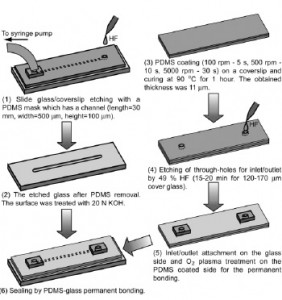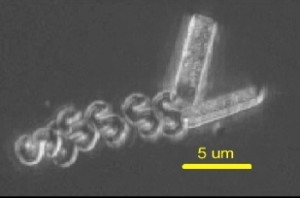Biohybrid robots
Under Construction
Ultra-smooth glass channels for bioassay with motor proteins

Optically-flat glass channels were fabricated for the non-fluorescent observation of bio-molecules. Two bioassays of motor proteins were successfully performed, in which nanoscale beads and microtubules were clearly observed by a differential interference contrast (DIC) microscope and a dark-field microscope, respectively. The concentration of hydrofluoric acid (HF) was optimized to obtain an optically flat surface which was evaluated by AFM, SEM and dark-field microscopy. A glass channel was etched using a poly(dimethyl siloxane)(PDMS) microfluidic channel as a mask and sealed with a PDMS-coated coverslip. The channel volume of 2-3 microl realized the drastic reduction of proteins required per assay compared with a conventional flow cell method requiring 20 microl.
Hybrid nanotransport system by biomolecular linear motors

We have demonstrated a novel micro/nanotransport system using biomolecular motors driven by adenosine triphosphate (ATP). For the driving mechanism, microtubule-kinesin system, which is one of the linear biomolecular motor systems was investigated. ATP dissolved in an aqueous condition is hydrolyzed to adenosine diphosphate (ADP) to energize the bionanoactuators in this mechanism. This means the system does not require an external electrical or mechanical energy source. Therefore, a purely chemical system which is similar to the in vivo transport will be realized. This paper reports some fundamental studies to integrate biomaterials and MEMS. The microtubules, or rail molecules, were patterned on a glass substrate with poly(dimethyl siloxane) (PDMS) using a regular soft lithography technique. Microbeads (320 nm in diameter) and a micromachined structure coated with kinesin molecules were transported along the microtubules. While ATP injection activated the transport system we have also managed to provide repetitive on/off control using hexokinase as an inhibitor. [Download the movie]
